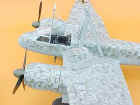|
The kit
I am a great fan of 1/48 DRAGON KITS, due to the quality of the moulding, the level of detail , and the comprehensive instructions. I bought this Mistel 2 in 1993 , but I assembled it few years ago.
When I first opened the big box, I was very impressed by the enormous quantity of injection molded parts (over 290 ) and the expensive decal sheet, which provides markings for three different models; the moldings have well executed engraved panels lines. Two aircraft are included: a FW190 F-8 and a JU 88 G-1.
The Junkers 88 have an interchangeable nose section to build either trainer version (Mistel S 2) or flying bomb version (Mistel 2), with three versions of hollow-charge warheads.
The JU 88 interiors includes instruments panel, seats, control column and side panel details; but no photo- etched parts (like seat belts or harnesses); the landing gear details are goods. Except for a few minor fit problems , Dragon´s Ju 88 G kit in this scale is a beauty . In the case of the FW 190 F-8, the cockpit interior is very good, and the fully detailed sliding canopy is a gem for this scale. Some reviewers have reported problems with the fit of the wings and fuselage parts, but my kit had no such problems. The fit was excellent, and I only use bare minimum of filler.
There is same unorthodox design in the Mistel kit, making it necessary to follow the detailed instructions closely and carefully. The 33 steps instructions sheet shows the assembly of FW 190 (steps 1 to 5) and Ju 88 G-1 assembly (steps 16 to 32) ; the last step 33 shows the final assembly between both aircraft. An entire page of painting and markings drawings shows the top, bottom and left side of model.
|

|